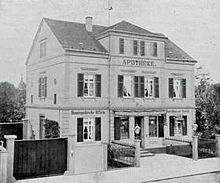Pharmacy in Kötzschenbroda
The pharmacy zu Kötzschenbroda , the Löwen pharmacy from 1871 to 1902 and the city pharmacy since 1929 , is located at Bahnhofstrasse 19 on the corner of Hermann-Ilgen-Strasse in the Kötzschenbroda district of the Saxon city of Radebeul . The listed building was erected on this site in 1867 and belonged to Hermann Ilgen around 1890 , who made his fortune with his rat and mouse poison production there and earned the nickname “Mäusetod”.
description
The original building was a two-story residential building with a central projectile with a rafter gable under a flat gable roof. The two-storey, Art Nouveau extension from 1904 on Hermann-Ilgen-Strasse has a polygonal floor plan.
The Art Nouveau alignment of the building led to a “picturesque, uniform assembly group” with concave undulating gables in the main and side views with a mansard tent roof. The plastered building is structured by pilaster strips as well as different structural plasters and a few stucco work .
In the left side view there is a two-story arcade architecture with half-timbering and an auxiliary building. The entrance in the middle of the building was given a curved copper canopy.
history
The pharmacist Irmler opened the first pharmacy in Lößnitz as early as 1760, but converted it into a general store in 1772. This was where the exclusive salt trading license for Kötzschenbroda lay until the 19th century. In the building Altkötzschenbroda 48 there was a sparkling wine cellar for a short time from 1845 and from 2002 the restaurant "Alte Apotheke".
In the Kötzschenbroda village of 1803, the pharmacy law is explicitly mentioned, but it was not until 1826 that Johann Gottlieb Strasser opened a new pharmacy in Kötzschenbroda in what is now Kötitzer Strasse, at that time with an attached materials store. His successor Friedrich Waldemar Vogel moved the pharmacy to the building at Bahnhofstrasse 19 on December 24, 1870 and renamed it "Löwen-Apotheke". The building was built in 1867 for the farmer and landowner Karl Traugott Schubert by the master builder August Große . Heinrich Moll bought the pharmacy in 1875.
Moll's successor Hermann Ilgen took over the run down Löwen pharmacy in 1882 or 1888 for the enormous purchase price of 120,000 marks , which he completely renovated. During this time Ilgen brought a new type of rat and mouse poison onto the market, the phosphor pill , which he was able to sell successfully worldwide, which earned him the nickname “Mouse Death” in addition to a large fortune. The purchase price is explained by the fact that Ilgen's predecessor had already produced the mouse poison in his pharmacy.
In 1883 Ilgen had married Anna Mathilde Steffen from Leipzig, whereby he was related to the wealthy Leipzig building officer Otto Heinrich Steffen. His wife owned valuable land near what is now Leipzig Central Station. In the same year Ilgen co-founded the Sparkasse in Kötzschenbroda, which moved into a building right next to his pharmacy. After the pharmacy was sold to Gustav von Schleppegrell in 1892 or 1894, Ilgen moved to Dresden , where he devoted himself to real estate business and his patronage .
The owner from 1903, pharmacist Curt Schnabel, renamed the pharmacy "Apotheke zu Kötzschenbroda" and in 1904 had Georg Heinsius von Mayenburg (realized by Alfred Große ) add an Art Nouveau extension to the side facing Hermann-Ilgen-Straße. In 1907 the style of the main building was adapted by the same architect and the shop front was built. Schnabel was made an honorary citizen of the city of Kötzschenbroda in 1926. His son-in-law took over the business in 1927, and his family continued to run it until 1969.
From 1969 to 1972 and again in 1999/2000 the building was extensively renovated.
literature
- Frank Andert (Red.): Radebeul City Lexicon . Historical manual for the Loessnitz . Published by the Radebeul City Archives. 2nd, slightly changed edition. City archive, Radebeul 2006, ISBN 3-938460-05-9 .
- Volker Helas (arrangement): City of Radebeul . Ed .: State Office for Monument Preservation Saxony, Large District Town Radebeul (= Monument Topography Federal Republic of Germany . Monuments in Saxony ). SAX-Verlag, Beucha 2007, ISBN 978-3-86729-004-3 .
Web links
Individual evidence
- ^ Large district town of Radebeul (ed.): Directory of the cultural monuments of the town of Radebeul . Radebeul May 24, 2012, p. 9 (Last list of monuments published by the city of Radebeul. The Lower Monument Protection Authority, which has been based in the Meißen district since 2012, has not yet published a list of monuments for Radebeul.).
- ↑ Volker Helas (arrangement): City of Radebeul . Ed .: State Office for Monument Preservation Saxony, Large District Town Radebeul (= Monument Topography Federal Republic of Germany . Monuments in Saxony ). SAX-Verlag, Beucha 2007, ISBN 978-3-86729-004-3 .
- ↑ a b c d journal; University of Leipzig. May / June 2005. Issue 3/2005. P. 40f. ( Page no longer available , search in web archives ) Info: The link was automatically marked as defective. Please check the link according to the instructions and then remove this notice.
- ↑ a b History of the Radebeul City Pharmacy
Coordinates: 51 ° 6 ′ 21.8 " N , 13 ° 37 ′ 45.3" E






